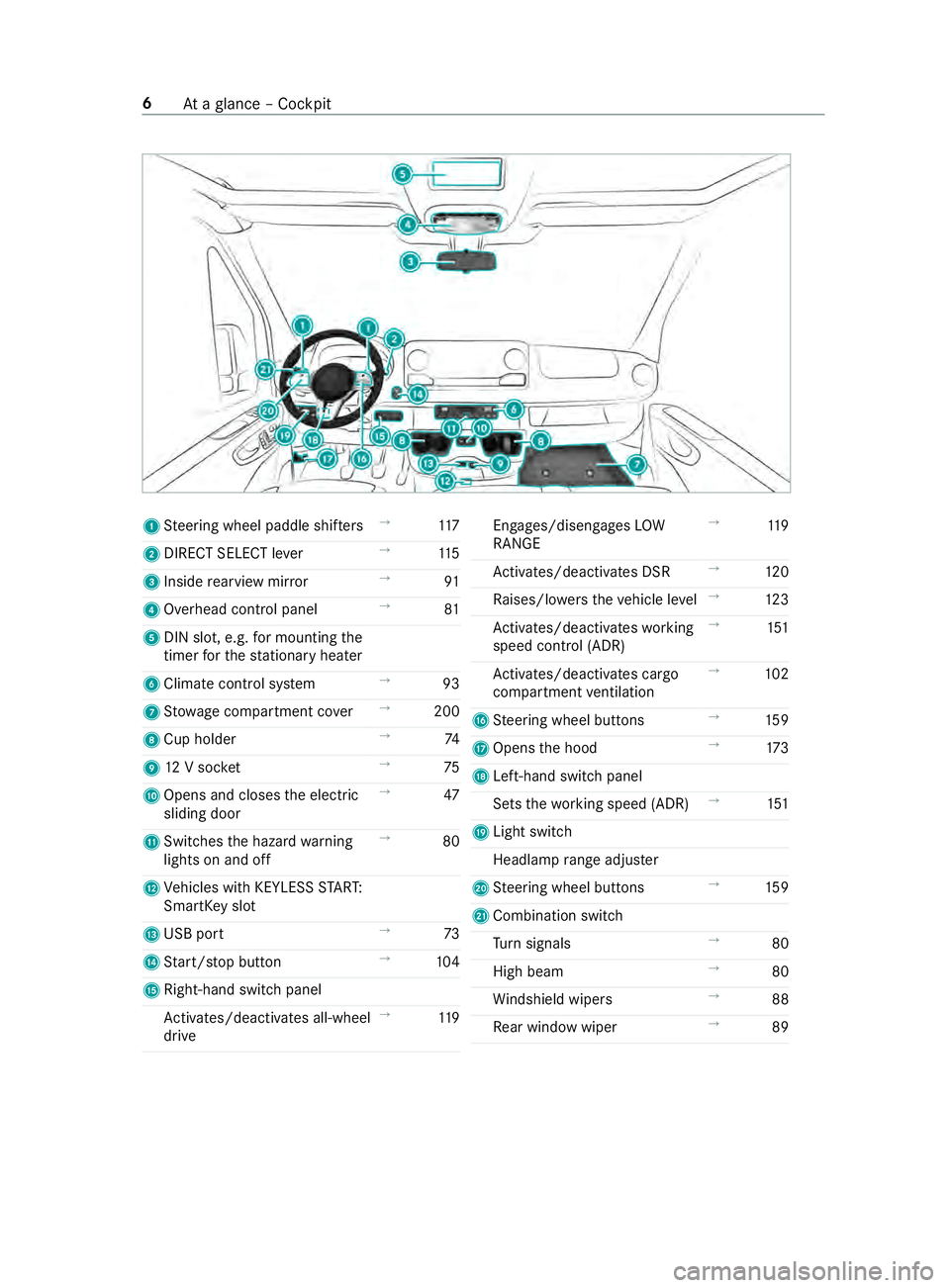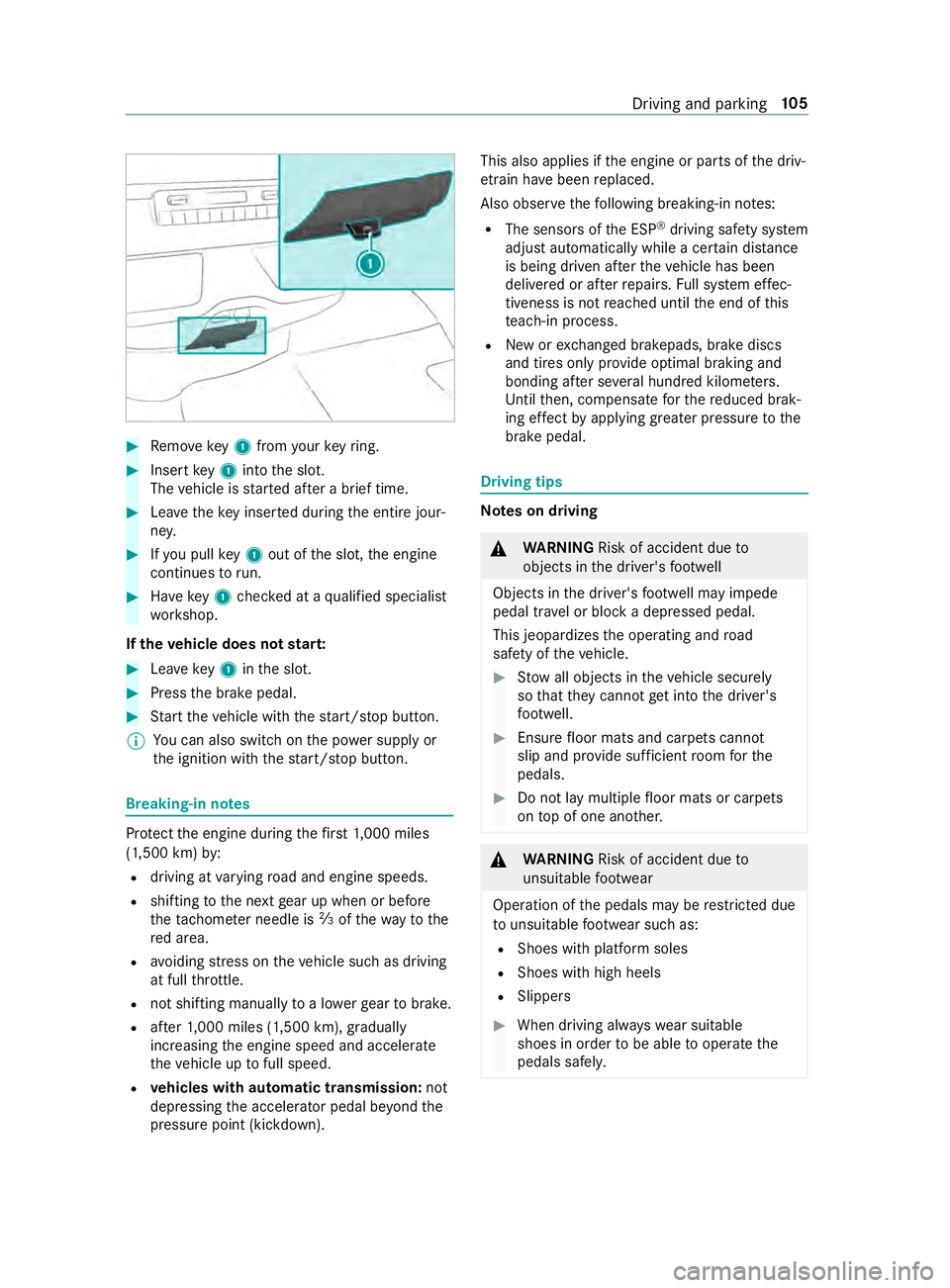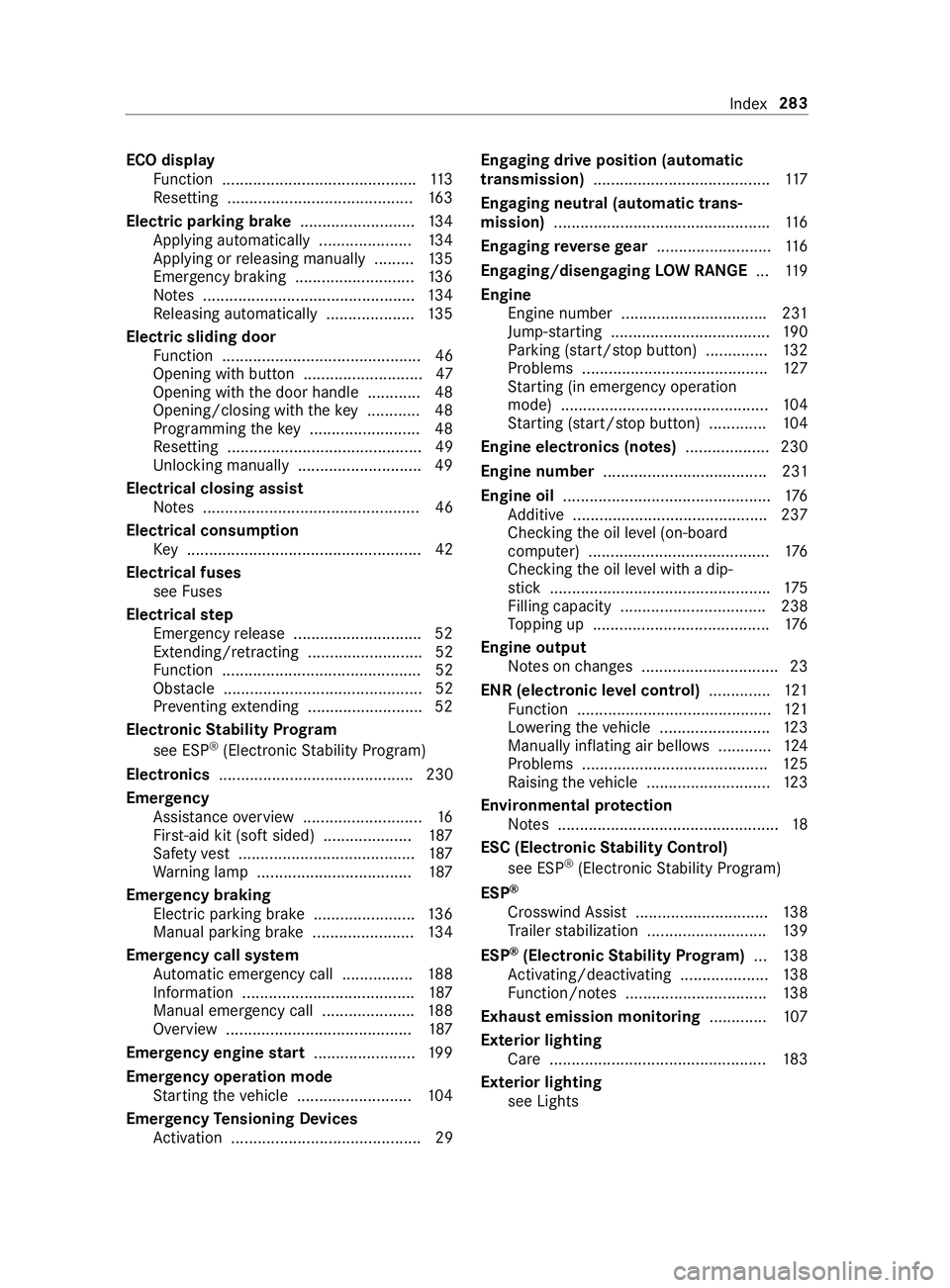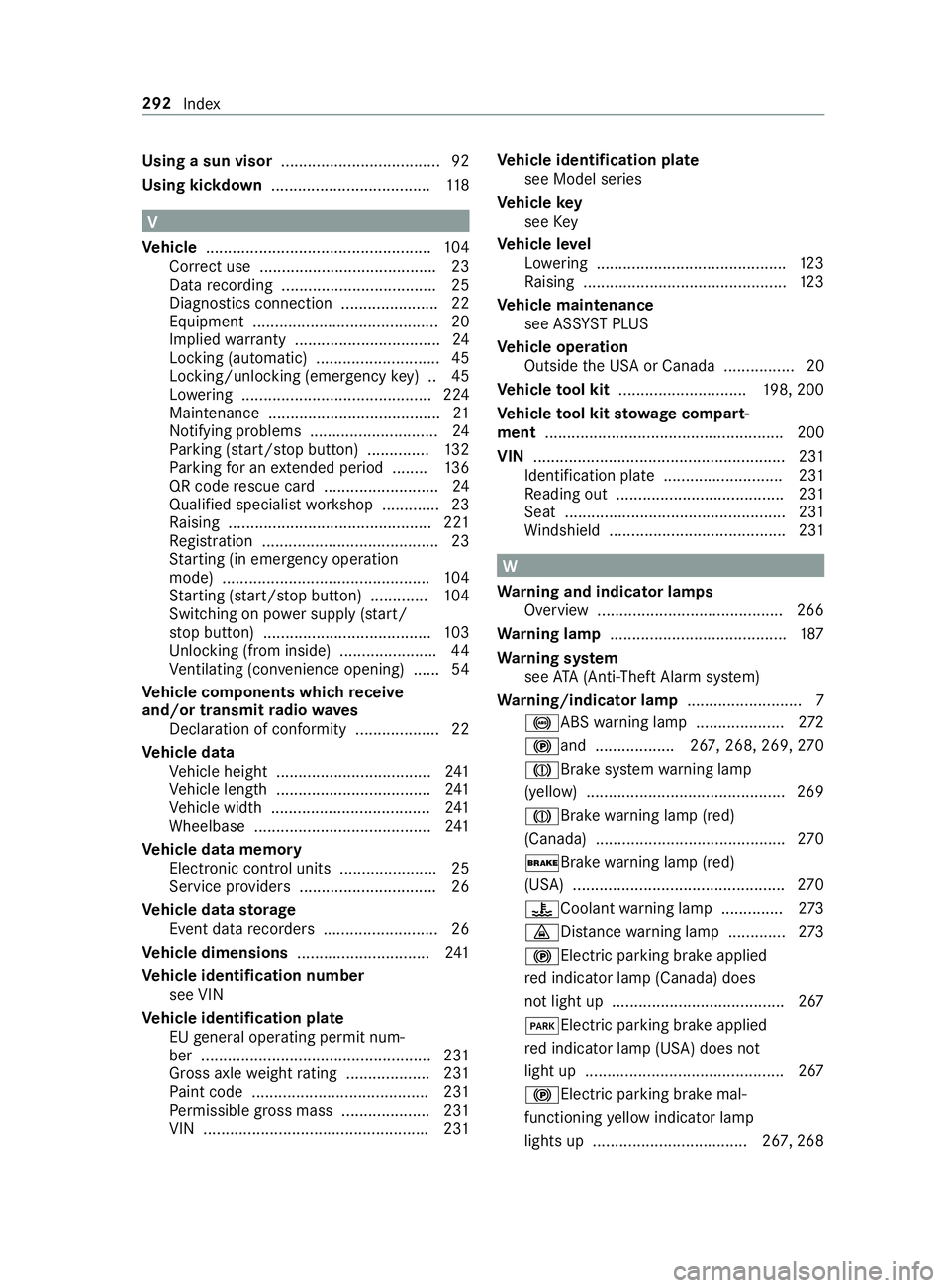start stop button MERCEDES-BENZ SPRINTER 2019 MY19 with no MMS Operator’s Manual
[x] Cancel search | Manufacturer: MERCEDES-BENZ, Model Year: 2019, Model line: SPRINTER, Model: MERCEDES-BENZ SPRINTER 2019Pages: 322, PDF Size: 5.91 MB
Page 30 of 322

1
Steering wheel paddle shif ters →
11 7
2 DIRECT SELEC Tlever →
11 5
3 Inside rearvie wmirror →
91
4 Overhead control panel →
81
5 DIN sl ot,e .g. form ounting the
time rfor thes tationar yheater
6 Climat econtrol sy stem →
93
7 Stow agec ompartment co ver→
200
8 Cuph older →
74
9 12Vsocket →
75
A Opens and closes thee lectric
sliding door →
47
B Switches theh azar dwarning
light sona nd off →
80
C Vehicles wit hKEYLESSS TART:
SmartK eyslot
D USB port →
73
E Start/ stop button →
104
F Right-hand swit chpanel
Ac tivates/deacti vatesa ll-wheel
drive →
11 9 Engages/disengages
LOW
RANGE →
11 9
Ac tivates/deacti vatesD SR →
12 0
Ra ises/lo wersthev ehicle le vel→
12 3
Ac tivates/deacti vatesw orking
speed control (ADR) →
151
Ac tivates/deacti vatesc argo
compartment ventilation →
102
G Steering wheel buttons →
15 9
H Opens theh ood →
173
I Left-hand switc hpanel
Sets thew orking speed (ADR) →
151
J Light switch
Headlam prang eadjus ter
K Steering wheel buttons →
15 9
L Combination swit ch
Tu rn signals →
80
High beam →
80
Wi ndshield wipe rs →
88
Re ar wind owwiper →
89 6
Atag lanc e–Cockpit
Page 65 of 322

SmartK
ey Note
sonr adio connection softhekey &
DANG ER Risk of fata linjur ytop ersons
wit hm edical devices from thee lectro‐
magnetic radiation of thes tart/s topb ut‐
ton
Pe rsons wit hmedical devices, e.g. pacemak‐
er sord efibrillators:
When youo perat ethe start/ stop button, a
ra dio connection is es tablished between the
ke ya nd thev ehicle.
The electromagnetic radiation can af fect the
functionality of amedical device. #
Befor eoperating thev ehicle, consult
yo ur doc torort he manufacturer of the
medica ldevice abou tany possible
ef fects of emissions from suc hsystems. De
tection rang eoft he KEYLESS-S TART func‐
tion antenna Overvie
wofSmartK eyfunctions &
WARNING Risk of accident and inju ry
due tochildren lef tunat tende dint he
ve hicle
If ch ildren ar eleftu nat tende dint hevehicle,
th ey could:
R opendoors,t hereb yendangering other
persons or road users.
R geto utofthev ehicle and be hit by
oncomin gtraffic.
R operat evehicle equipment and become
trapped, fore xamp le.
In addition ,children could also se tthe vehicle
in motion, fore xamp le,by:
R releasing thep arking brake. R
shifting thea utomatic transmission out of
par kposition 005D.
R startin gthe engine #
Neverlea ve children and animals unat‐
te nde dint hevehicle. #
When leaving thev ehicle, alw ayst ake
th eS martK eywit hyou and loc kthe
ve hicle. #
Keep theS martK eyout of ther eac hof
ch ildren. *
NO
TEDama getothek eycaused bymag‐
netic fields #
Keep thek eyaway from strong mag‐
netic fields. 1
Tolock
2 Battery checkl amp
3 Tounlo ck
4 Tounlo ckthec argo compartmen t(sliding
door sand rear-en ddoors)/ tounlo ckand
open/close electric slidin gdoors
5 Mechanical key
The SmartK ey's factor ysetting enables youto
centrally loc kand unloc kthe following compo‐
nents:
R The driver's door and thec o-driver door
R The sliding doors
R The rear-en ddoors
% If
yo udon otopen thev ehicle within appr ox‐
imatel y40seconds of unlocking, thev ehicle
will loc kagain and anti-thef tprotection will
be activated again. Opening and closing
41
Page 79 of 322

#
Tointer rupt convenience closing: release
the 0037 button. Re
setting thes ide windo ws The side windo
wsmus tber esetafter am alfunc‐
tion or avoltag esuppl yinter ruption. #
Swit chon thei gnition (/ page103). #
Pushbothw indo wlifte rb uttons and hold for
appr oximately one second af tert he side win‐
do wh as closed. Problems with
thes ide windo ws Problem
Possible causes/consequences and 0050 0050Solutions
As ide windo wcann otbe
closed and thec ause is
no to bvious. #
Chec ktos ee ifther ea reanyo bject sinthe windo wguide.
& WARNING Risk of becoming trapped or fata llyi njured if reve rs‐
ing pr otection is no tactivated
If yo uc lose aside wind owagain immediatel yafter it has been
bloc ked, thes ide windo wwill close wit hincreased or maximum
fo rc e. The reve rsing featur ewillthen no tbea ctive.
Pa rtsoft he body could become trapped in thec losing area in the
process. #
Mak esuret hat no parts of theb ody ar einthe closing area. #
Tostop thec losing process, release theb utton or press the
button again tore-ope nthe side windo w. If
as ide windo wisobstructed during closing, and reopens again slightl y,
yo uc an proceed as follo ws: #
Immedia tely afte rt he windo wisobstructed, pull thec orresponding
button again until thes ide windo whas closed, and hold theb utton
fo rana dditional second.
The side windo wisclosed wit hincrease dforce.
If th es ide windo wisobstructed again and reopens slightl y,yo uc an pro‐
cee dasf ollows: #
Repeat thep reviou sstep.
The side windo wisclosed without thea utomatic reve rsing function.
The side windo wscannot
be opened or closed
using thec onvenience
opening feature. The SmartK
eybatter yisweak or discharged. #
Chec kthe batter ywitht he batter ychec klam pand replace if neces‐
sar y(/pag e42). Anti-thef
tprote ction Fu
nction of thei mmobilizer The immobilize
rpreve nts your vehicle from being
st ar tedw ithout thec orrect key.
The immobilizer is automaticall yactivated when
th ei gnition is switched off, and deactivated when
th ei gnition is switched on. When leaving
thev ehicle, alw ayst aket he key
wit hyou and loc kthe vehicle. If thek eyis left
inside thev ehicle, an yone can star tt he engine.
% In
thee vent thee ngine does no tstart despi te
th ev ehicle's star terb atter yhaving suf ficient
ch arge ,the immobilizer is defective. Contact
aq ualified specialis tworks hop or call
1-800-367-63 72(intheU SA)or
1-800-387-0 100( in Canada). Openin
gand closing 55
Page 129 of 322

#
Remo vekey 1from your keyr ing. #
Inser tkey 1 intot he slot.
The vehicle is star teda fter ab rief time. #
Leavethek eyinser tedd uring thee ntir ejour‐
ne y. #
Ifyo up ullkey 1out of thes lot, thee ngine
continues torun. #
Have key 1checkedataq ualified specialist
wo rkshop.
If th ev ehicle doe snotstar t: #
Leavekey 1inthes lot. #
Press theb rake pedal. #
Startt he vehicle wit hthe start/ stop button.
% Yo
uc an also swit chon thep ower suppl yor
th ei gnition wit hthe start/ stop button. Breaking-in no
tes Pr
otect thee ngine during thef irst 1,000 miles
(1,500 km) by:
R driving at varying road and engine speeds.
R shiftin gtothe next gear up when or before
th et achome tern eedle is 00C3ofthew ay to the
re da rea.
R avoiding stre ss on thev ehicle suc hasdriving
at full thro ttle.
R nots hifting manuall ytoalowergear tobrake.
R afte r1 ,000 miles (1,50 0km),gradually
increasing thee ngine speed and accelerate
th ev ehicle up tofull speed.
R vehicles with automatic transmission: not
depressing thea ccelera torp eda lbeyo ndthe
pressur epoint (kickdown). This also applies if
thee ngine or parts of thed riv‐
et ra in ha vebeen replaced.
Also obser vethef ollowing breaking-in no tes:
R The sensor softhe ESP ®
driving saf etys ystem
adjus tautomaticall ywhile acertai nd ista nce
is bein gdrive na fter thev ehicle has been
delivered or af terr epairs. Full sy stem ef fec‐
tivenes sisnotreached until thee nd of this
te ach-in process.
R Newore xchanged brakepads, brak ediscs
and tires onl yprovide optimal braking and
bonding af ters everal hundred kilome ters.
Un tilthen, compensat efor ther educed brak‐
ing ef fect by applying greater pressur etothe
brak epedal. Driving tips
Note
sond riving &
WARNING Risk of accident du eto
object sinthe driver's foot we ll
Object sinthe driver's foot we ll ma yimp ede
pedal tr avel or bloc kadepressed pedal.
This jeopardizes theo perating and road
saf etyoft hevehicle. #
Stow all object sinthevehicle securely
so that they canno tget intot he driver's
fo ot we ll. #
Ensur efloor mats and carpets cannot
slip and pr ovide suf ficient room fort he
pedals. #
Do no tlay multiple floor mats or carpets
on topofo ne ano ther. &
WARNING Risk of accident du eto
unsuitable foot we ar
Operatio nofthe pedals ma yberestricted due
to unsuitable foot we ar suc has:
R Shoes wit hplatform soles
R Shoes wit hhigh heels
R Slippers #
When driving alw aysw ear suitable
shoes in order tobe able tooperat ethe
pedals safel y. Driving and pa
rking 105
Page 146 of 322

The jac
kmaytip. #
Press theS ervice button on thea ir sus‐
pension remo tecontrol befor eraising
th ev ehicle.
This pr events au tomatic readjustment
of thev ehicle le vela nd pr events it from
being raised or lo weredm anually. &
WARNING Risk of accident du etolow‐
ered or raised chassis
Drivin gwithal oweredorr aised chassis may
greatl yimp air brakin gand handlin gcharac‐
te rist ics. Youm ayalso exceed thep ermissible
ve hicle height when thec hassi sisraised. #
Setthe driving le velb efor epulling away. &
WARNING Risk of accident from mal‐
function of electronic le velc ontrol
If elect ronic le velc ontrol is malfunctioning,
th ev ehicle le velm aybe asymmetrical, too
high or tool ow.
The driving and steering characteristic softhe
ve hicle ma ybenoticeabl ydiffe re nt. #
Adapty our driving stylea ccording lyand
driv ecarefull y. #
Stop, paying attention toroad and traf‐
fi cc onditions. #
Consul taqualified specialis tworks hop. *
NO
TERisk of damag etothechassis from
lo we redv ehicle le vel If electronic le
velc ontrol is malfunctionin gor
re adjusts while youa redriving, thev ehicle
le ve lm aybe lo wered. #
Paya ttention tother oad conditions and
ensur ether eiss ufficient ground clear‐
ance. #
Driv ecarefully. The le
veloft hevehicle depends on vehicle load
and thel oad distribution. Elect ronic le velc ontrol
adjusts thel evel of ther ear axle automaticall yon
ve hicles wit hanair-sprung rear axle .The vehicle
le ve list hereb yalway sm aintained at thed riving
le ve l,re ga rdless of vehicle load. Driving dynamics
re main unaf fected. The height dif fere nce
between thes ides of thev ehicle ma ybeupto
0.4 in (1 cm). Electronic le
velc ontrol is no tengine-dependent
and is onl yoperational when thei gnition is
switched on. The electronic le velc ontrol com‐
pressor worksa udibl y.
% If
th ec ompressor worksc ons tantly or starts
up se veraltimes per minute, elect ronic le vel
control is malfunctioning.
Depending on thev ehicle equipment, electronic
le ve lc ontrol switches between manual and auto‐
matic mode depending on either thev ehicle
speed or thep osition of thep arking brake.
If electronic le velc ontrol switches depending on
ve hicle speed, manual operation is automatically
activated when thev ehicle is stationar y.Yo um ay
ra ise or lo werthe vehicle le vel. If yous ubse‐
qu ently drivefastert han 6mph (1 0km/h), man‐
ual mode is automaticall ydeactivated and auto‐
matic mode sets thev ehicle le vel.
If elect ronic le velc ontrol switches depending on
th ep arking brak eposition ,manual mode is auto‐
maticall yactivated when thep arking brak eis
applied. Youm ayraise or lo werthe vehicle le vel
to load and unload. If your elease thep arking
brake, manual mode is automaticall ydeactivated
and automatic mode sets thed riving le vel.
When working on thev ehicle or changing a
wheel, youc an deactivat eelectronic le velc ontrol
(/ page123).
If electronic le velc ontrol is malfunctionin gorthe
ve hicle le velist oo high or tool ow ,ana udible sig‐
nal sounds.
The drivin gand steering characteristic softhe
ve hicle will be noticeably dif fere nt. Electronic
le ve lc ontrol adjusts thev ehicle le veltot he nor‐
mal le velass oon as possible. Continue driving
carefull yuntil thea udible signal stops. Onl ythen
is thev ehicle at normal le vel.
Au tomatic mode and electronic le velc ontrol
automaticall yswitc hona gain to restor et he vehi‐
cle le vel, depending on theo ption selected:
R when thep arking brak eisreleased
R from speeds of appr oximatel y6mph
(1 0k m/h)
If th ee lectronic le velc ontrol compressor thre at‐
ens to ov erheat, e.g. due torepeated raising or
lo we ring wi thin as hor tperiod, elect ronic le vel
control is deactivated. Youc an raise or lo werthe
ve hicle le vela ga in af tera pproxima tely
one minu te. 12 2
Driving and pa rking
Page 159 of 322

The electric parking brak
eisalso automatically
applied if ActiveD ista nce Assi stDISTRONI Chas
brought thev ehicle toas tandstill.
In addition ,atleastone of thef ollowing condi‐
tions mus tbefulfilled:
R thee ngine is switched off
R thed rive risn otsitting in thed rive r's seat
R theb elt buckle is undone
R ther eisas ystemm alfunction
R thep owe rsupply is insuf ficient
R thev ehicle is stationar yfor along time
The red0049 and0024 (USA) or 0024(Canada)
indicator lam pinthe instrument displa ylights up.
The electric parking brak eisonlya ctuall yapplied
when ther ed 0049 and0024 (USA) or 0024
(Canada) indicator lamps light up continuousl y.
Re leasing thee lectric pa rking brak eautomat‐
ically
Ve hicles with automatic transmission:
The electric parking brak eofyourvehicle is
re leased when all of thef ollowing condition sare
fulfilled:
R The driver is sitting in thed rive r's seat.
R The driver is belted.
R The engine is running.
R The transmissio nisinposition005Bor005E and
yo ud epress thea ccelera tor
or
Yo us wit ch from transmission position 005Dto
position 005Bor005E.Y ou mus talso depress the
accelerator if tra veling on steep uphill gradi‐
ents.
R Ifth et ransmission is in position 005E,therear-
end door smustbec losed.
App lying/releasing thee lectric pa rking brake
manually &
WARNING Risk of accident and inju ry
due tochildren and animals lef tunat ten‐
de dint hevehicle
If yo ul eave children and animals unat tended
in thev ehicle, they ma ybea bletos etthe
ve hicle in motion, fore xamp leby:
R Releasing thep arking brake.
R Shifting thea utomatic transmission out of
par kposition 005D. R
Startin gthe engine.
In addition, they ma yoperat evehicle equip‐
ment and become trapped. #
Neverlea ve children and animals unat‐
te nde dint hevehicle. #
When leaving thev ehicle, alw ayst ake
th eS martK eywit hyou and loc kthe
ve hicle. #
Toappl y:press switch 1.
When thee lectric parking brak eisapplied,
th er ed 0049 and0024 (USA) or 0024(Can‐
ada) indicator lamps light up in thei nstru‐
ment displa y.The electric parking brak eis
onl yactuall yapplied when ther ed 0049
and 0024 (USA) or 0024(Canada) indicator
lamps light up continuousl y.
It is also possible toappl ythe electric parking
brak ewhen thei gnition is switched off. #
Torelease: pull switch 1.
The red0049 and0024 (USA) or 0024(Can‐
ada) indicator lamps in thei nstrument display
go out.
Yo um ayonlyrelease thee lectric parking
brak eift he ignition is switched on wit hthe
st art/ stop button. Driving and parking
13 5
Page 307 of 322

ECO display
Functio n............................................ 11 3
Re setting. ......................................... 16 3
Electric pa rking brake .......................... 13 4
App lying automaticall y..................... 13 4
Applying or releasing manuall y......... 13 5
Emer gency braking ........................... 13 6
No tes. ............................................... 13 4
Re leasing automaticall y................... .135
Electric slidin gdoor
Fu nctio n............................................. 46
Opening wi thbutton ...........................47
Opening wit hthe door handle ............ 48
Opening/closing wit hthe key. .......... .48
Prog ramming thek ey ........................ .48
Re setting. ........................................... 49
Un lockin gmanuall y........................... .49
Electrical closing assist Notes. ................................................46
Electrical consum ption
Ke y. .................................................... 42
Electrical fuses see Fuses
Electrical step
Emer gency release ............................ .52
Extending/r etra cting .......................... 52
Fu nctio n............................................. 52
Obs tacle ............................................. 52
Pr eve nting extending ......................... .52
Electronic Stability Prog ram
see ESP ®
(Electronic Stabilit yProgram)
Elect ronics ............................................ 230
Emer gency
Assis tance overview. .......................... 16
Fir st-ai dk it (so ftsided) .................... 187
Saf etyv est. ....................................... 187
Wa rning lam p................................... 187
Emer gency braking
Elect ricp arkin gb rake ...................... .136
Manual parking brak e....................... 13 4
Emer gency call sy stem
Au tomatic emergency call ............... .188
Informatio n....................................... 187
Manual emer gency cal l..................... 188
Overvie w.......................................... 187
Emer gency engine start ....................... 19 9
Emer gency operation mode
St artin gthe vehicle .......................... 104
Emer gency Tensioning Devices
Ac tivation ........................................... 29 En
gaging driv eposition (automatic
transmission) ........................................ 11 7
Engaging neut ral(automatic trans‐
mission) ................................................ .116
Engaging reve rseg ear ........ .................. 11 6
Engaging/disengaging LOWR ANGE ...11 9
Engine Engin enumber ................................ .231
Jump-s tarting .................................... 19 0
Pa rking (s tart/s topb utton) .............. 13 2
Problems .......................................... 127
St artin g(in emer gency operation
mode) ............................................... 104
St artin g(start/ stop button) .............1 04
Engine electronics (no tes) ...................2 30
Engine number ..................................... 231
Engine oil ............................................... 176
Ad ditiv e........................................... .237
Checkin gthe oil le vel(on-board
computer) ........................................ .176
Checkin gthe oil le velw ithad ip‐
st ick. ................................................ .175
Filling capacity ................................. 238
To pping up ........................................ 176
Engine output Notesonc hanges ............................... 23
ENR (electronic le velc ontrol) .............. 121
Fu nctio n............................................ 121
Lo we ring thev ehicle .........................1 23
Manually inflatingair bello ws............ 124
Problems .......................................... 12 5
Ra ising thev ehicle ............................1 23
Environmental pr otection
No tes. ................................................. 18
ESC (Electronic Stability Control)
see ESP ®
(Electronic Stabilit yProgram)
ESP ®
Crosswind Assis t.............................. 13 8
Tr ailer stabilizatio n........................... 13 9
ESP ®
(Electroni cStabilit yProgram) ...13 8
Ac tivating/deactivating .................... 13 8
Fu nction/no tes. ............................... 13 8
Exhaus temission moni toring .............1 07
Exterior lighting Care................................................. 183
Exterior lighting see Lights Index
283
Page 316 of 322

Using
asun visor .................................... 92
Using kickdown .................................... 11 8V
Ve hicle ................................................... 104
Cor rect us e........................................ 23
Dat arecording ................................... 25
Diagnostic sconnection ...................... 22
Equipment .......................................... 20
Implie dwarrant y. ................................ 24
Locking (auto matic) ............................ 45
Locking/unlocking (emergency key) .. 45
Lo we ring ........................................... 224
Maintenance ....................................... 21
Notify ing problems ............................ .24
Pa rking (s tart/s topb utton) .............. 13 2
Pa rking forane xtende dperio d........ 13 6
QR code rescue car d.......................... 24
Qualified specialis tworks hop .............23
Ra ising .............................................. 221
Re gistration ........................................23
St artin g(in emer gency operation
mode) ............................................... 104
St artin g(start/ stop button) .............1 04
Switching on po wersupply (s tart/
st op button) ...................................... 103
Un lockin g(from inside )..................... .44
Ve ntilating (co nvenience opening) ...... 54
Ve hicl ecom ponents whic hreceive
and/or transmit radio waves
Declaration of conformity ................... 22
Ve hicl edata
Ve hicle height ................................... 241
Ve hicle lengt h................................... 241
Ve hicle widt h.................................... 241
Wheelbase ........................................2 41
Ve hicl edata memory
Electronic control units ...................... 25
Service pr ovider s............................... 26
Ve hicl edata storage
Event data recorder s.......................... 26
Ve hicl edimensions .............................. 241
Ve hicl eidentification number
see VIN
Ve hicl eidentification plate
EU general operating pe rmit num‐
ber .................................................... 231
Gross axle weight rating ................... 231
Pa int code ........................................ 231
Pe rm issible gross mass .................... 231
VIN .................................................. .231 Ve
hicl eidentification plate
see Mode lseries
Ve hicl ekey
see Key
Ve hicl elevel
Lo we ring ........................................... 12 3
Ra ising .............................................. 12 3
Ve hicl em aintenance
see ASS YSTP LUS
Ve hicl eoperation
Outside theU SAor Canada ................20
Ve hicl etool kit ............................ .198, 200
Ve hicl etool kit stow agec om part‐
ment ...................................................... 200
VIN ......................................................... 231
Identification pla te........................... 231
Re adin gout ...................................... 231
Seat .................................................. 231
Wi ndshield ........................................ 231 W
Wa rning and indicator lamps
Overvie w......................................... .266
Wa rning lamp ........................................ 187
Wa rning sy stem
see ATA( Anti -Thef tAlarms ystem)
Wa rning/indicator lamp .......................... 7
0025AB Swarning lam p................... .272
0024 and .................. 267, 268, 269, 270
004D Brakesystemw arning lamp
(yellow) ............................................ .269
004DBrak ewarning lam p(red)
(Canada) .......................................... .270
0027Brak ewarning lam p(red)
(USA) ................................................ 270
00AC Coolan twarning lam p............. .273
00BA Distance warning lam p............. 273
0024 Electric pa rking brak eapplied
re di ndicator lam p(Canada) does
no tlight up .......................................2 67
0049 Electric pa rking brak eapplied
re di ndicator lam p(USA) does not
light up .............................................2 67
0024 Electric pa rking brak emal‐
functioning yello wi ndicator lamp
light sup. .................................. 267, 268292
Index